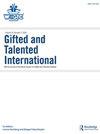Raising the bar for mathematically gifted students through creativity-based mathematics instruction
Q3 Social Sciences
引用次数: 0
Abstract
ABSTRACT Student ability to demonstrate mathematical creativity positively affects their mathematical learning. Further, creativity-based mathematical instruction (CBMI) may enhance divergent thinking and precipitate a highly creative mathematical learning environment . In this literature review and discussion, it is posited that CBMI has distinctively beneficial influences on mathematically gifted students’ learning processes and products. With CBMI, a value is placed on creative output, which differs from dispositions generated in algorithmically based classrooms, which may arrest creative or divergent thought. Procedure-based teacher instruction abates mathematically gifted students’ creative possibilities and restricts their thinking potential. By placing unnecessary constraints on mathematical thought, teachers restrict mathematically gifted students’ ability to produce divergent thoughts that may lead to creative products. Contemporary interpretations of giftedness include creativity as a characteristic, and therefore should be considered in mathematical learning episodes. By incorporating CBMI and promoting a mathematical environment in which creativity is valued, mathematics classrooms are raising the learning ceiling for mathematically gifted students. CBMI allows students to explore concepts and construct understanding conceptually and creatively.通过基于创造力的数学教学提高数学天才学生的标准
摘要:学生展示数学创造力的能力对他们的数学学习有积极影响。此外,基于创造力的数学教学(CBMI)可以增强发散思维,并促成高度创造性的数学学习环境。在这篇文献综述和讨论中,我们认为CBMI对数学天才学生的学习过程和产品有着独特的有益影响。在CBMI中,创造性输出是有价值的,这与基于算法的课堂中产生的倾向不同,后者可能会阻碍创造性或发散性思维。基于程序的教师教学削弱了数学天才学生的创造力,限制了他们的思维潜力。通过对数学思维施加不必要的约束,教师限制了数学天才学生产生发散思维的能力,从而可能产生创造性的产品。当代对天赋的解释包括创造力作为一种特征,因此应该在数学学习中加以考虑。通过纳入CBMI并促进重视创造力的数学环境,数学课堂正在提高数学天才学生的学习上限。CBMI允许学生从概念上和创造性地探索概念和构建理解。
本文章由计算机程序翻译,如有差异,请以英文原文为准。
求助全文
约1分钟内获得全文
求助全文

 求助内容:
求助内容: 应助结果提醒方式:
应助结果提醒方式:


